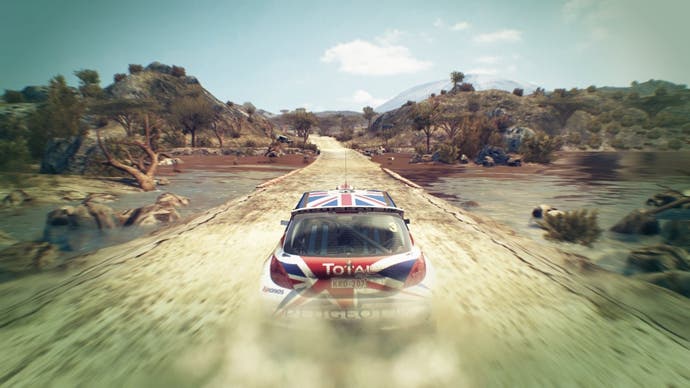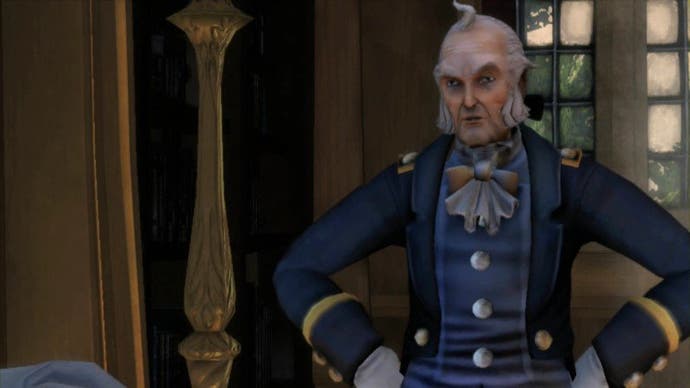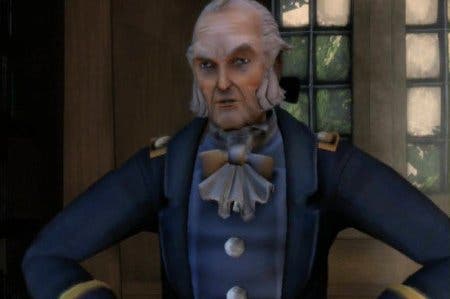Strange Tales From The Studio
Investigating some of the odder roles in games development.
We all know the drill. New game gets announced, studio bigwig witters on about the big vision, there's a bunch of stats for the trainspotters and then months later - bang! - a finished game. But what happens in the meantime is still vague, mysterious and messy. Rarely does anyone think of the men and women on the game development frontline who quietly toil away to produce the magic that eventually emerges on a diet of little more than Pepsi and pizza.
So we tracked down some of the developers whose smaller, more specialist contributions usually get overlooked to see what really happens on the game development factory floor. Surprisingly there wasn't much talk of Pepsi or even pizza, but there were stories about topless a-list celebrities, armed guards and some unusual applications for meat.
Take the level designers and artists who craft the tracks in Codemasters' rally driving series Dirt; as part of their research for the games they get to travel around the world on fact-finding missions to places as diverse as Tokyo, Michigan and Kenya. These trips are not a jolly though, says Jason Evans, the lead level designer for the forthcoming Dirt Showdown. "It's invaluable to have actually been there, seen things and recorded it," he says. "When it comes to designing tracks and environments that information is priceless."
These research trips usually last five days and involve two artists and two level designers combing locations with video and photo cameras at the ready. "The artists go for the textures and assets while the level designers will be looking at all sorts of things, from the track surface to what the environment is like around the track and how that adds to the characteristics we are trying to get out of the level," says Evans.
It's a curious job that attracts some curious reactions. "We've had instances where the police have turned up because we were taking pictures of the wrong buildings," says Evans. "Banks tend not to welcome us taking lots of pictures of their buildings either, while in Colorado we had to photograph a small section of a town and the bank staff came out to see who I was and what I was up to."

Then there was the trip to Kenya for Dirt 3, where Evans and the team spent much of their time living up to the game's title by crawling around on their hands and knees. "For things like the edges of the road we do drop down and get the camera right on the floor to capture the detail. In Kenya we had these armed guards with us because we were researching in the safari park itself. They found us utterly bizarre because there were elephants and zebras and all these animals around and we're just there on the floor taking pictures of rocks and the gravel."
It's not the sort of thing you get praised for, but if it doesn't work properly it's going to get criticized even though when it does work no-one notices. It's a nightmare but someone's got to do it. - Jim Vale, Lionhead
The Codemasters team usually returns from these trips with around 30,000 photographs and a great many hours of video. That then needs to be sorted out and filed in the studio's enormous research library so they can be called on when the time to build and draw the tracks comes.
Indeed the size of big-budget games means that processing huge amounts of sound, art and other assets is a challenge for developers in all kind of roles. Jim Vale, the outsourcing manager at Lionhead Studios, had the unenviable job of sifting through Fable 3's 6000-plus clothing combinations.
In all it took Vale three months of painstaking mixing and matching to ensure the game's fashions not only worked but looked great too. "That's three months I'm never getting back," he says. "People were surprised I was being that thorough - but the thing is if I wasn't the game would have gone out with lots of clothing bugs. It's not the sort of thing you get praised for, but if it doesn't work properly it's going to get criticized even though when it does work no-one notices. It's a nightmare but someone's got to do it."
The game's skirt and jacket combos stick in his mind as true horrors. "We couldn't get the long jackets working with the skirts for ages - they would just clip through," he recalls. "Then we decided to make all the long jackets tuck into the skirts, but that meant all the skirts had to be wider around the waist to accommodate the jackets. So having checked a lot of jackets already I had to go back and redo them. It's one of those things you couldn't really plan for until you got all the clothing into the game itself."
Equally daunting is the amount of dialogue in Fable games. Georg Backer got put in charge of the casting actors for Fable 2, a role that soon expanded to encompass the entire dialogue production process. "That included finding a casting director, managing the budgets and recording all the dialogue," he says. "Then you realise that you've got about 370,000 words to record."
The voice recording sessions for Fable 2 and 3 both took three to four months, and every day was spent at the studio. "We had four directors because it was so big, including one who specialised in working with kids because we wanted proper kids' voices in the game."
Getting through the mountains of dialogue was a challenge especially when last-minute changes to the script were a common occurrence. "It'll be like 's**t, the script has changed in the last 48 hours so the dialogue will need a rewrite but the actors for that part are coming tomorrow'," he recalls.

"We would have to get it written, approved and into the systems while making sure it doesn't affect anything else. If you change some dialogue but you've already recorded one character's part you have to figure out if you can keep it or have to re-record it. You end up deep in Excel, Access and these data script programs that store all the text, going through 50,000 to 60,000 lines of dialogue trying to figure out what impact the change might have. The writers end up working 24-7."
On the upside he did get to work with the star-studded cast assembled to bring Fable's characters to life. "People in the office always said I had the luckiest job because I got to work with all the famous people, but it's not like you have hour-long chats with them as you've got to get recording," says Backer, who has since left Lionhead to pursue what he teasingly describes as a 'secret mission'.
That said, seeing the characters of the game brought to life by the actors is one of the great thrills of the job: "It was a real pleasure to see Stephen Fry bring Reaver to life. He took Reaver and made him this really memorable character. It's always amazing to see the characters you've been working on for six months come to life in a moment. It's difficult to describe the feeling - a smile just breaks across your face."
Sometimes the smiles give way to giggles: "It can be hard to stop people giggling. Fable is a big world where the player can do strange things like knocking on villagers' doors in the night and all these events had to be covered in the dialogue. All of them were written to be funny in the first place but lots of these lines often unveiled their full effect when performed."
Among the sessions filled with guffawing was Fable 3's gnome song with its chants of "pointy little hat" and "two foot tall". "Recording the garden gnomes for Fable 3 was very, very funny," says Backer. "The song was done by recording a few actors individually - not in a group - because that way we were able to live mix and group and layer them together in the game. The good thing is that if you laugh a lot in the studio at the right material then you know there is no reason why it shouldn't work in the game."
Sometimes, though, the recording sessions don't go to plan. Kate Saxon, a freelance performance director who worked on Fable 3 and James Bond 007: Blood Stone, recalls one such time: "One funny story is in Fable 3 when John Cleese was working in the voiceover booth. He had a beautifully pressed shirt on and, as I'm sure everyone knows, he gesticulates a lot; he is very demonstrative in the way he performs and the same happens in the voiceover booth."
As he performed, Cleese's immaculate shirt crackled in unison with his expressive arm movements. "I had to keep coming in over the intercom and saying 'John, what you're doing is brilliant, but your shirt is as loud as your voice so I'm going to have to ask you to do it again'. This kept going on and on because John couldn't stay still during the performance, so in the end he says: 'Right! Ok! Right! That's enough!' and takes his shirt off. So I had a 70-year-old John Cleese with his belly out for the rest of the session until I told him I couldn't bear it any longer and went to get him a t-shirt."

When it comes to audio, however, it's the sound effects designers rather than the voiceover directors who do the strangest things. Pawel Blaszczak, the sound effects designer on Techland's tropical zombie romp Dead Island, says finding the right noises to communicate the atmosphere of a game can demand oddball approaches.
"I would say that aural sensations account for 50% of the gaming experience even though we might not realise it consciously," he says. "Finding the right sounds for our zombies in Dead Island was a challenge. Initially we tried basing them on animal sounds. They were scary and cool but not believable enough. In the end we arranged very demanding recording sessions with live actors."
Having tested the vocal limits of actors and actresses, Blaszczak also found sonic opportunities within Techland's own offices. "Several ambient effects like wind, scraping and other random noises were created from a recording of a broom sweeping tiles in the corridors of our office building," he reveals, "and when the zombies are trying to break into a barricaded room what you hear is an enhanced sound of Techland employees abusing the door to my office."
Vegetables and various fruits can have their moments: smashing melons or squashing tomatoes is both satisfying and useful - Pawel Blaszczak, Techland
Manipulating recorded sounds is a big part of the job, and the disquieting jungle noises of Dead Island are a prime example: "I used the typical jungle ambient recordings with monkey screams and all that, changing the pitch and adding convolution reverb. In the end players can never be sure if they hear monkeys, zombies or something else entirely. This uncertainty leads players to question other sounds and the imagination becomes my ally in creating the appropriate mood."
When not using audio to mess with player's heads, Blaszczak messes with food to get the perfect sounds for when beating a zombie with a canoe paddle or nail-studded baseball bat. "Hitting actual meat works best: chicken, beef, pork," he says. "Of course I buy the stuff - no animals were harmed and all that. Vegetables and various fruits can have their moments: smashing melons or squashing tomatoes is both satisfying and useful."
So next time you get your hands on a brand new game, spare a thought for the developers in the shadows: the ones who checked that that you could wear that ill-advised skirt and jacket combo, the actors who crumpled their shirts and the directors who had to witness it, and the artists who crawled around in the dirt and dung. Remember them, and the animals whose ultimate fate was to end up as meat being savagely tenderised in a recording studio for the sake of our entertainment.









